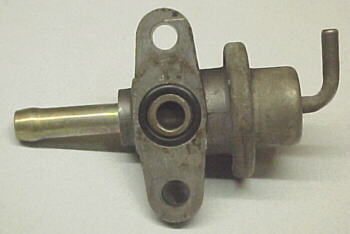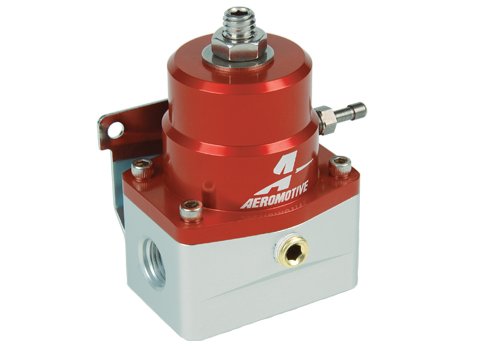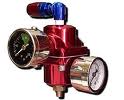| What's Hot! | Products/ Tools | EFI Tuning | Basic Tuning | Advanced Tuning | Chassis Tuning | Advertise with us |
Fuel Pressure Regulator
Contributed By: SDSEFI
Basic Operation
EFI fuel pressure regulators come in various shapes and sizes but their purpose is the same- to hold the fuel pressure at a certain differential above the intake manifold pressure. The inner mechanism usually consists of a sealed diaphram chamber, a spring, a diaphram, bypass valve and a manifold pressure reference port. The valve is connected to the diaphram and the spring pushes against the diaphram from the manifold pressure side. The spring pressure determines the static fuel pressure. If there is vacuum on the port, say at idle, this reduces the effective spring pressure acting on the diaphram and reduces the fuel pressure under vacuum conditions. If there is pressure on the port, such as under boost, this effectively increases the spring pressure, thus fuel pressure.
Most OE regulators use a one to one ratio. At one psi of boost, it would add one psi of fuel pressure. This way there is always a constant pressure differential across the fuel injector. Most regulators have a static pressure of between 38 and 44 psi. The fuel pump always puts out an excess of fuel volume. The regulator controls the pressure in the fuel rail by bypassing any fuel not used by the engine back to the fuel tank once the control pressure is met. At idle, perhaps 95% of the fuel delivered to the fuel rail is returned to the tank. At full power, perhaps 5% to 50% of the fuel delivered is returned back to the tank. Fuel is generally routed from the pump to one end of the fuel rail which feeds the injectors. The regulator is usually mounted on the opposite end of the rail. This arrangement allows any hot fuel in the rail to be immediately purged back to the tank after a hot start to reduce vapor lock and fuel boiling. A similar arrangement should be used if you are fabricating your own fuel system.

Rising Rate Regulators Some aftermarket companies produce fuel pressure regulators which have a ratio of higher than one to one. These are intended for use mainly on engines which were not factory turbocharged. Because the fuel injection system was never designed or mapped for the increased levels of airflow, fuel flow and manifold pressure, these regulators attempt to supply increased fuel under boost by vastly increasing fuel pressure. This is a bad idea for several reasons:
1. Fuel delivery varies as the square of the fuel pressure so you need 4 times the pressure to double the flow, say 160 psi in most cases.
2. The fuel injectors, hoses and fuel pumps were never designed to operate at this pressure. Pump life is severely reduced, injectors may not operate properly leading to a lean out condition and a component may fail causing a fuel leak and fire.
3. Fuel delivery under boost is now under the control of a mechanical device rather than the ECU so mixture control is crude at best.


The proper course is to use a system designed for turbocharged operation with appropriately sized injectors for the job. The OE regulator in most cases is well capable of controlling the pressure and because you can flow a lot of fuel through a 5/16 hole at 40 psi, they are entirely adequate up to 500 hp in most cases. There is no need to install larger fuel lines or massive regulators for most applications. Most aftermarket regulators are not required and a waste of time and money for street applications. They might be required at extreme hp levels on race applications or those using methanol where higher fuel flow rates demand larger lines and regulator passages. The fuel pump may have to be upgraded if the power levels are increased substantially over stock however.
If you're currently in the market for a fuel pressure regulator, we here at enginebasics.com have had great success with the following:
***Remember*** to check for other relevant information in the columns and article tables.
ATTENTION READER:
If you enjoyed the information and article you just read be sure to check out our newly released book with even more exciting photo's and information:How to Turbocharge and Tune your Engine

Want to know more about your particular Make and Model vehicle? All of these vehicles are covered in the tech, maintenance and repair articles found above. Enginebasics is the wiki or wikipedia of car part, repair, how to and tuning information. Let us be the class 101 for your automotive learning.
| Ford | General Motors GM | Pontiac | Jaguar | Land Rover | Nissan |
| Toyota | Honda | Lexus | Acura | Lotus | Scion |
| Infinity | BMW | Mercedes | Mitsubishi | Ferrari | Maserati |
| Lamborghini | Volks Wagen VW | Saab | Audi | Hyundai | Kia |
| Subaru | Mazda | Chevy | Volvo | Caddilac | Dodge |
| Chrylser | Daewoo | Porsche | Mercury | Freightliner | MG |
Individual Models
| Ford Mustang | Mitsubishi Eclipse | Mitsubishi Evo | Subaru WRX / STI | Dodge Viper | Chevrolet Corvette |
| Nissan Skyline | Honda S2000 | Nissan 350z | Toyota Supra | Chevy Camaro | Lotus Elise Exige |
| Honda Civic | VW Golf | Dodge SRT-4 | Eagle Talon | Acura Integra | BMW M3 |
| Nissan 240sx | Porsche 911 | Acura NSX | Honda Accord | Toyota Camry | Toyota MR2 |
| VW R32 | Dodge Truck | Mazda Rx7 | VW Jetta | Sand Buggy | Nissan Sentra |
For the latest Automotive news and stories visit the websites below |
Our feature Build: An AWD V6 Civic




